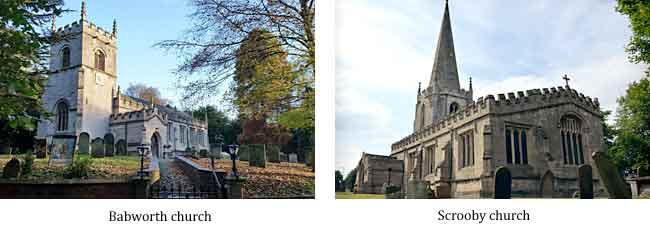
Structural
Standing buildings

The main church buildings in Nottinghamshire linked to the movement are Babworth and Scrooby, together with Austerfield which although in Yorkshire was part of the Nottingham Archdeaconry.
Sturton-le-Steeple is also of significance, although only the tower remains from the church that was known by John Smyth and John Robinson. Even the font would not have been known by Smyth as it was brought from West Burton after the fire. Sturton was also the home of the White family, of whom Katherine went to America with her husband John Carver.
Worksop Priory is connected to the movement through the vicar having been Richard Bernard, who briefly ‘separated’ but is also noteworthy through its links with his daughter Mary who with her husband Roger Williams effectively founded the US state of Rhode Island. The Priory was partially in ruins at that time, notably the nave was the main section remaining in use. It is highly likely that the Gatehouse was used as the vicarage and that this was where Mary Bernard was born.
The church at Marnham is important as the first local parish of Richard Clifton, who rose to fame at Babworth, and also because of the arrest there of John Smyth and other puritan ministers.
Headon church was a centre of radical puritanism and saw the first known deprivation of a clergyman in the area in the 1568. Despite this, John Swinscoe later held livings at Marnham and then Saundby – both radical puritan centres. Robert Southworth was deprived here in 1605.
Scrooby is famous for William Brewster and for a few months was where members of the movement gathered after Richard Clifton was deprived of his position at Babworth. As Brewster lived in part of the Archbishop’s Palace, this site is very significant although how much of the present farmhouse would have been used by him has been debated. More tangible is the old Parsonage House next to the church, which would have been used by the curates appointed by Brewster.

Austerfield Manor, which although in Yorkshire was always treated as in Nottinghamshire for Church purposes, is the almost complete house known to William Bradford. It is close to the church, which has an excellent window depicting scenes from the life of Bradford.
Bilborough: Thomas Helwys, one of the key members of John Smyth’s congregation, lived here after his father leased Broxtowe Hall. Thomas erected a memorial to his father which can be seen in the church. During the crisis over separation, Helwys moved to Basford but the precise location is not known. There is also a Helwys family memorial at Saundby.
Ruins and earthworks
As noted above, only fragments remain of the Palace at Scrooby although extensive earthworks, moats and fishponds remain visible.
Habblesthorpe: an early historian of the Pilgrims claimed a link between the separatist and future Baptist John Smyth and this ‘lost’ village, where a cousin of Thomas Helwys also held land. Records do show a ‘Smyth’ in Helwys’s household. Some remains of the churchyard can be identified.
Beauvale Priory: The White family of Sturton-le-Steeple moved to Beauvale and so John Robinson came here to woo his bride Bridget. He married her at Greasley in 1604. Bridget’s sister married John Carver, who Robinson made the first leader of the ‘Mayflower’ travellers.
Broxtowe Hall: a fragment of the estate wall can still be seen. This was the home of Thomas Helwys, who helped fund the final escape from England and later returned to start a Baptist church.